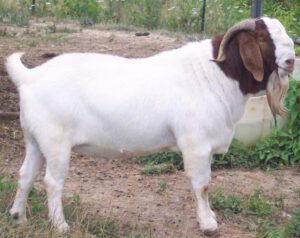The Aspromonte goat is an indigenous breed of domestic goat raised for meat and milk production. It is also known as Capra dell’Aspromonte or Aspromontana.
The breed is named and actually from the mountain massif of the Aspromonte, in the province of Reggio Calabria in Calabria in southern Italy. Aspromonte goat is raised only in the province of Reggio Calabria, mainly in the Aspromonte, in the Altipiano dello Zomaro (Zomaro plateau) to the north-east, and in the Ionian coastal areas of the province, and particularly in areas of Grecanic culture.
The breed is thought to have originated from the Aspromonte. But it may have been influenced by the various other goat breeds. These goat breeds include Maltese goat, Abyssinian goat and a type known as “Tibetan” with long silky hair.
Importation of the Tibetan type to Calabria in the early 20th century is well documented. The Aspromonte goat is one of the 43 autochthonous Italian goat breeds of limited distribution for which a herdbook is kept.
The herdbook is kept by the Associazione Nazionale della Pastorizia, the Italian national association of sheep- and goat-breeders.
Registered population of the Aspromonte goat was variously reported as 27,164 and as 26,249 at the end of 2013. Today the breed is used as a dual-purpose animal and used for both meat and milk production.
Aspromonte Goat Characteristics
The Aspromonte goat is a medium sized dual-purpose breed of goats. Their head is small with a straight profile. Their ears are horizontal or erect. Their abdomen is fairly large for the size of the animal with a straight back, and a moderately sloping developed rump.
The does have firmly attached udders with medium sized teats. Both bucks and does are bearded and usually have horns. Head and horns of the bucks are larger than the does. The bucks also have stronger limbs and coarser hair.
The coat of the Aspromonte goat is long with a cashmere-type undercoat, and usually ruddy. Their coat color vary. Most common colors are red and white, black and white, grey, brown, brown and red and particolored.
Average height of the Aspromonte does is about 69 cm, and 73 cm for the bucks. The bucks on average weight about 64 kg, and average body weight of the does is about 43 kg. Info from Wikipedia.
Uses
Aspromonte goat is a dual-purpose animal. It is raised primarily for meat and milk production. But the breed is somehow good for wool production.
Special Considerations
The Aspromonte goat is a very strong and hardy breed of goat. These goats play a very important role in vegetation management and maintenance of the mountain pasture. The does are pretty good milk producers.
Minimum milk yield of the Aspromonte nannies is 120 liters in 150 days for primiparous, 130 liters in 160 days for secondiparous and 180 liters in 210 days for pluriparous animals.
Reported averages for the Aspromonte goat are, respectively, 140 liters in 150 days, 150 liters in 160 days, and 220 liters in 210 days. The Aspromonte goats are very fertile. Annual fertility rate of the does is 98 percent, with average age of first parturition of 15 months.
Milk of the Aspromonte goat is of very good quality. Their milk averages 3.95 percent fat, 4.63 percent lactose and 3.57 percent protein. Their milk is used for making various types of milk products.
Meat of the Aspromonte goat is also of good quality. And it is considered as a good meat goat breed. Review full breed profile of the Aspromonte goat in the following table.
| Breed Name | Argentata dell’Etna |
| Other Name | Capra dell’Aspromonte or Aspromontana |
| Breed Purpose | Milk & Meat |
| Breed Size | Medium |
| Buck | About 64 kg |
| Doe | About 43 kg |
| Horns | Yes |
| Climate Tolerance | All Climates |
| Coat Color | Many |
| Good for Stall Fed | Not Sure |
| Rarity | Common |
| Country/Place of Origin | Italy |






